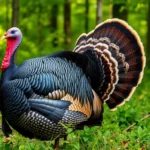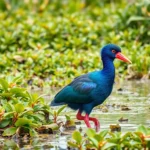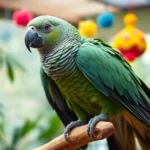When we think of nature’s most skilled aerial pirates, the frigate bird immediately soars to the top of our list. These magnificent seabirds have mastered the art of survival through a combination of breathtaking flight abilities and surprisingly cunning behavior that’s both fascinating and slightly notorious.
We’ve all heard of pirates ruling the seas, but frigate birds have claimed dominion over tropical and subtropical coastlines worldwide. With their distinctive inflatable red throat pouches, massive wingspans, and razor-sharp flying skills, these birds don’t just catch their own fish – they’re notorious for harassing other seabirds until they surrender their hard-earned meals.
What makes these aerial acrobats truly remarkable isn’t just their piratical tendencies. We’re talking about birds that can soar for weeks without landing, sleep while flying, and perform aerial maneuvers that would make fighter pilots jealous. Their unique adaptations and behaviors offer us incredible insights into evolution and survival strategies.
What Is a Frigate Bird
Frigate birds are large seabirds belonging to the family Fregatidae, consisting of 5 distinct species that inhabit tropical and subtropical coastal regions worldwide. These remarkable avians measure between 35 to 45 inches in length and possess wingspans reaching up to 7.5 feet, making them among the most impressive aerial hunters in marine environments.
Physical Characteristics define frigate birds through several distinctive features:
- Inflatable throat pouch: Males display bright red gular sacs during breeding season that expand to basketball size
- Forked tail: Deeply scissored tail feathers provide exceptional maneuverability during flight
- Hooked beak: Sharp curved bills measure 4 to 5 inches long for catching fish and squid
- Waterproof deficiency: Reduced preen gland produces minimal oil, limiting waterproofing capabilities
- Lightweight build: Hollow bones and minimal body fat create the lightest body weight relative to wingspan among all birds
Taxonomically, we classify frigate birds into five species: Magnificent Frigatebird (Fregata magnificens), Great Frigatebird (Fregata minor), Lesser Frigatebird (Fregata ariel), Christmas Frigatebird (Fregata andrewsi), and Ascension Frigatebird (Fregata aquila). Each species occupies exact geographic ranges across Pacific, Atlantic, and Indian Ocean regions.
| Species | Weight Range | Wingspan | Primary Habitat |
|---|---|---|---|
| Magnificent Frigatebird | 2.4-3.4 lbs | 7.2-7.5 feet | Caribbean, Pacific coasts |
| Great Frigatebird | 2.2-3.5 lbs | 6.6-7.5 feet | Indo-Pacific islands |
| Lesser Frigatebird | 1.3-1.8 lbs | 6.1-6.4 feet | Indian, Pacific Oceans |
| Christmas Frigatebird | 2.6-3.5 lbs | 6.9-7.3 feet | Christmas Island only |
| Ascension Frigatebird | 2.2-2.9 lbs | 6.4-6.8 feet | Ascension Island only |
Behaviorally, frigate birds exhibit kleptoparasitism as their primary feeding strategy, forcing other seabirds like boobies, pelicans, and tropicbirds to regurgitate recently caught prey. This piracy behavior occurs through aerial harassment, where frigate birds grab tail feathers or wings of victim birds until they release their catch midair.
Physical Characteristics of Frigate Birds
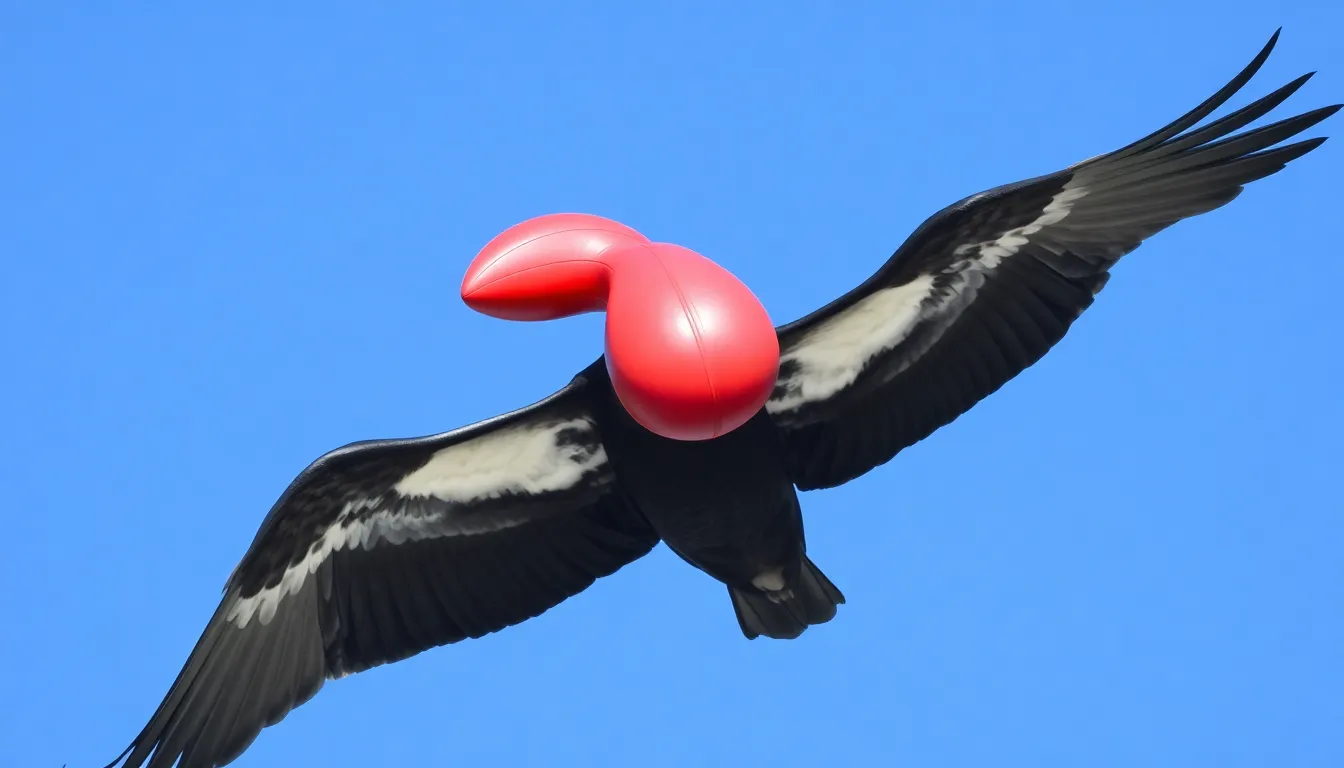
Frigate birds possess remarkable anatomical adaptations that distinguish them as nature’s most efficient aerial pirates. These specialized features enable their unique lifestyle of kleptoparasitism and extended oceanic flight.
Distinctive Features and Size
Adult frigate birds measure 35 to 45 inches in length with wingspans extending between 6 to 7.5 feet. Males typically weigh 2.4 to 3.5 pounds while females reach 2.8 to 4 pounds across all species. Their lightweight skeletal structure represents the highest wing area to body weight ratio among seabirds.
Distinctive anatomical features include a deeply forked tail that provides exceptional aerial maneuverability during pursuit flights. The hooked beak curves sharply downward and measures 4 to 5 inches long for grasping fish and harassing prey birds. Large webbed feet with sharp claws enable gripping branches during roosting even though their inability to dive underwater.
Their wings feature an exceptional aspect ratio with narrow pointed tips that reduce drag during soaring. Frigate birds maintain hollow bones throughout their skeleton which reduces total body weight by 15% compared to similarly sized seabirds.
Sexual Dimorphism and Coloration
Male frigate birds display striking sexual dimorphism through their inflatable red throat pouches called gular sacs. These bright crimson pouches expand to balloon size during breeding displays and can inflate to 8 inches in diameter. Males use these pouches alongside head shaking and wing spreading to attract females during courtship.
Female frigate birds lack the red throat pouch and instead feature white chest patches with dark brown to black plumage covering their wings and backs. Juveniles display white heads and underparts that gradually darken to adult coloration over 4 to 6 years.
| Species | Male Plumage | Female Chest | Juvenile Features |
|---|---|---|---|
| Magnificent | Black with purple sheen | White patch | White head and chest |
| Great | Black with green sheen | White chest band | Rusty head coloring |
| Lesser | Black overall | White chest patch | Brown and white streaking |
| Christmas | Black with bronze highlights | White underparts | Pale head with dark streaking |
| Ascension | Black with slight gloss | White chest marking | White head and neck |
Males across all species develop iridescent feather sheens ranging from purple to bronze that become more pronounced during breeding season.
Frigate Bird Species Around the World
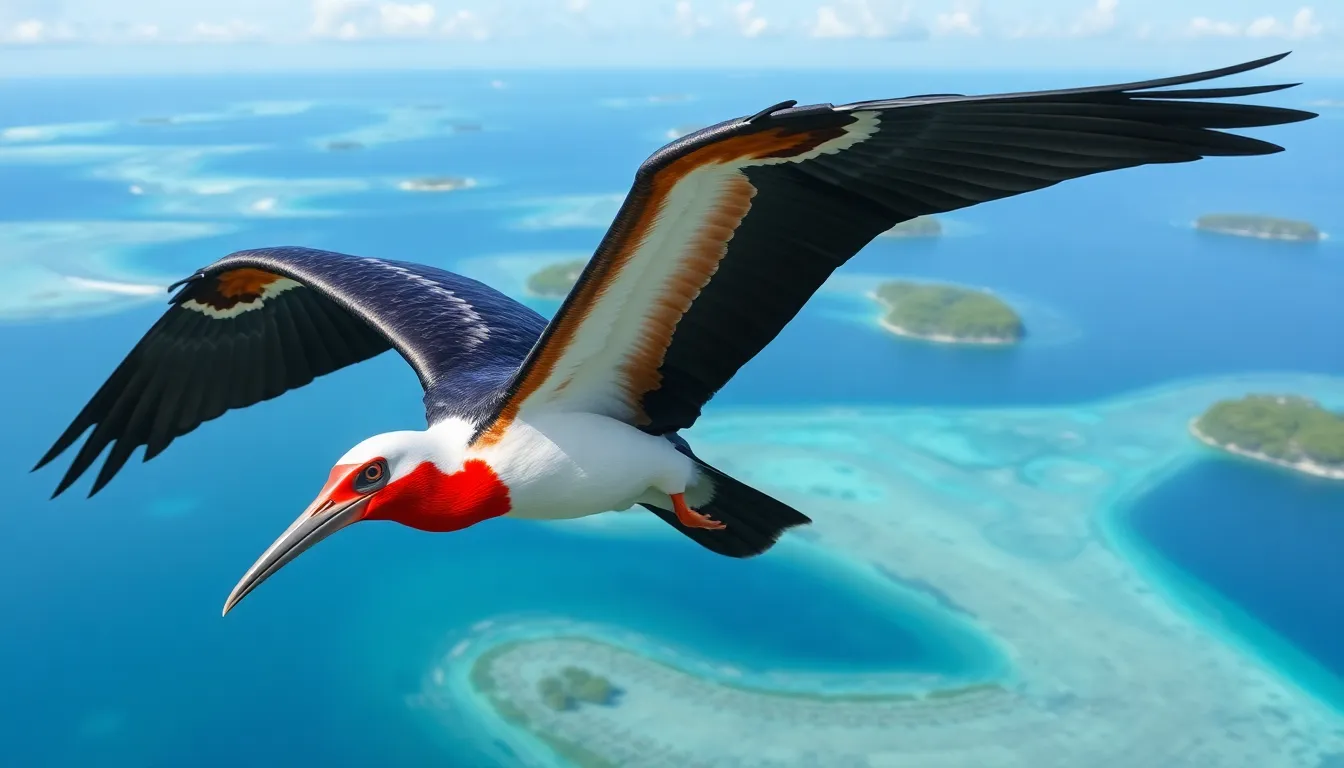
Five distinct frigate bird species inhabit coastal regions across the globe, each adapted to exact geographic ranges and environmental conditions. Understanding these species helps us appreciate the remarkable diversity within the Fregatidae family.
Magnificent Frigatebird
Magnificent Frigatebirds (Fregata magnificens) dominate the tropical coasts of the Americas, ranging from southern Florida through the Caribbean to Ecuador and the Galápagos Islands. Males measure 35 to 41 inches in length with wingspans reaching 7.5 feet, making them the largest frigate bird species by wingspan. Their striking red throat pouches inflate to the size of party balloons during breeding displays, creating one of nature’s most dramatic courtship rituals.
We observe these birds primarily along mangrove coastlines and coral atolls where they establish large breeding colonies. Females display distinctive white chest patches and weigh slightly more than males, averaging 3.3 pounds compared to males at 2.9 pounds. Their flight patterns include soaring at altitudes up to 8,200 feet, often remaining airborne for over a week without landing on water or ground.
Great Frigatebird
Great Frigatebirds (Fregata minor) inhabit the tropical Pacific and Indian Oceans, with major populations concentrated around Christmas Island, the Galápagos, and various Pacific atolls. These birds measure 34 to 40 inches in length with wingspans extending up to 7.3 feet, displaying remarkable sexual size dimorphism where females outweigh males by approximately 20 percent.
Males exhibit glossy black plumage with greenish sheens on their wings and backs, while their inflatable throat pouches turn bright orange-red during mating season. Colonies of Great Frigatebirds can contain over 10,000 breeding pairs, particularly on remote islands like Aldabra Atoll in the Seychelles. Their fishing techniques include surface skimming at speeds up to 25 mph and aggressive kleptoparasitism targeting boobies and tropicbirds.
Lesser Frigatebird
Lesser Frigatebirds (Fregata ariel) represent the smallest species within the family, measuring 30 to 32 inches in length with wingspans reaching 6.1 feet. We find these agile fliers throughout the tropical Indian Ocean and western Pacific, including Madagascar, the Maldives, northern Australia, and New Caledonia. Their compact size allows for exceptional maneuverability during aerial piracy attacks and fishing dives.
Breeding males develop distinctive white patches on their flanks and under their wings, contrasting sharply with their black plumage. Females weigh between 1.2 to 1.7 pounds while males average 1.1 to 1.5 pounds, making them significantly lighter than their larger cousins. Lesser Frigatebirds prefer nesting in low shrubs and bushes rather than tall trees, often establishing colonies of 200 to 500 pairs on isolated coral islands and rocky outcrops.
Habitat and Distribution

Frigate birds establish their territories across warm oceanic regions between 35°N and 35°S latitude. These master aviators concentrate their populations in areas where trade winds and thermal currents provide optimal flying conditions.
Tropical and Subtropical Regions
Pacific Ocean islands host the largest frigate bird populations, with colonies spanning from the Galápagos Islands to Australia’s Great Barrier Reef. The Magnificent Frigatebird dominates Caribbean waters and extends its range along the Pacific coasts of Central and South America. Great Frigatebirds populate remote atolls throughout the central Pacific, including Christmas Island, which supports over 10,000 breeding pairs.
Atlantic Ocean distributions center around tropical island chains such as the Cape Verde Islands and Ascension Island. The Lesser Frigatebird maintains colonies across Indian Ocean territories, particularly in the Seychelles and Mauritius regions. Water temperatures above 20°C (68°F) define the thermal boundaries of frigate bird territories, as these conditions support the fish populations they target.
Seasonal migrations occur within species ranges rather than long-distance movements to different climate zones. Frigatebirds follow prevailing wind patterns and seasonal prey abundance, with some populations traveling up to 3,000 kilometers during non-breeding periods. Trade wind zones provide the consistent air currents these birds exploit for their energy-efficient soaring flight patterns.
Nesting Colonies and Roosting Sites
Colonial nesting behavior characterizes all frigate bird species, with colonies ranging from 50 pairs to over 100,000 breeding birds. Low-growing shrubs and mangrove trees serve as primary nesting platforms, typically located 1 to 6 meters above ground level. The Christmas Frigatebird constructs nests exclusively on Pisonia trees, while Magnificent Frigatebirds prefer red mangrove environments.
Roosting sites concentrate on islands free from terrestrial predators, as frigate birds’ reduced waterproofing makes them vulnerable to ground-based threats. Established colonies often occupy the same locations for decades, with some sites showing continuous use for over 50 years. Protection from prevailing winds influences site selection, with colonies typically established on leeward slopes or sheltered valleys.
Breeding territories maintain strict boundaries, with nest sites spaced approximately 1 to 2 meters apart to prevent aggressive interactions. Outside breeding seasons, frigate birds form communal roosts containing hundreds of individuals, often sharing sites with other seabird species such as boobies and cormorants.
Human development pressures affect 60% of known frigate bird colonies worldwide, making undisturbed coastal areas increasingly valuable for population stability. Remote oceanic islands continue to provide the most secure habitats for these specialized seabirds.
Feeding Behavior and Diet

Frigate birds employ a sophisticated combination of aerial piracy and direct hunting to secure their daily sustenance across tropical waters. These remarkable seabirds dedicate 60% of their foraging time to kleptoparasitism while maintaining their capacity for independent prey capture.
Kleptoparasitism and Food Theft
Frigate birds execute their notorious food theft through precise aerial maneuvers targeting boobies, tropicbirds, and pelicans returning from fishing expeditions. We observe these pirates intercepting their victims at altitudes between 15 to 100 feet above sea level when the targeted birds carry visible prey in their beaks or throat pouches. The harassment technique involves grasping tail feathers, wing tips, or body parts of the victim bird while both species remain airborne.
Males demonstrate superior kleptoparasitic success rates at 75% compared to females at 45% due to their larger size and more aggressive pursuit tactics. A single theft event typically lasts 30 to 90 seconds before the harassed bird regurgitates its catch. Frigate birds then dive with remarkable precision to catch the falling fish before it hits the water surface.
Target species include brown pelicans, masked boobies, red-footed boobies, and tropicbirds that carry fish weighing between 0.2 to 2.5 pounds. Research indicates frigate birds steal approximately 40% of their total caloric intake through these piracy operations during peak breeding seasons. The success rate varies by colony location with Pacific populations achieving theft success rates of 68% while Atlantic colonies average 52%.
Fishing Techniques and Prey Selection
Frigate birds employ surface skimming and shallow diving techniques to capture prey independently in waters less than 6 feet deep. These seabirds cannot dive deeply due to their reduced waterproofing compared to other marine birds, limiting their fishing activities to surface waters and tide pools. We document frigate birds using their hooked beaks to snatch flying fish, squid, jellyfish, and small fish swimming near the surface.
Primary prey species include flying fish (40% of direct catches), juvenile tuna (25%), sardines (15%), anchovies (10%), and various cephalopods (10%). Adult frigate birds consume between 0.8 to 1.2 pounds of food daily depending on their size and breeding status. Females require higher caloric intake during egg production periods, increasing their consumption to 1.5 pounds per day.
Foraging typically occurs during early morning hours between 5:00 AM and 9:00 AM when prey fish are most active near the surface. Evening hunting sessions from 4:00 PM to sunset provide secondary feeding opportunities when thermal currents remain favorable for extended flight. Frigate birds demonstrate remarkable timing by coordinating their hunting with tide changes that concentrate small fish in shallow coastal areas.
The birds exhibit prey size selectivity, targeting fish between 2 to 8 inches in length that they can swallow whole during flight. Frigate birds reject prey exceeding 10 inches due to handling difficulties while maintaining aerial stability. Colony proximity to productive fishing grounds directly correlates with breeding success rates, with colonies located within 25 miles of upwelling zones producing 30% more fledglings than distant populations.
Breeding and Reproduction
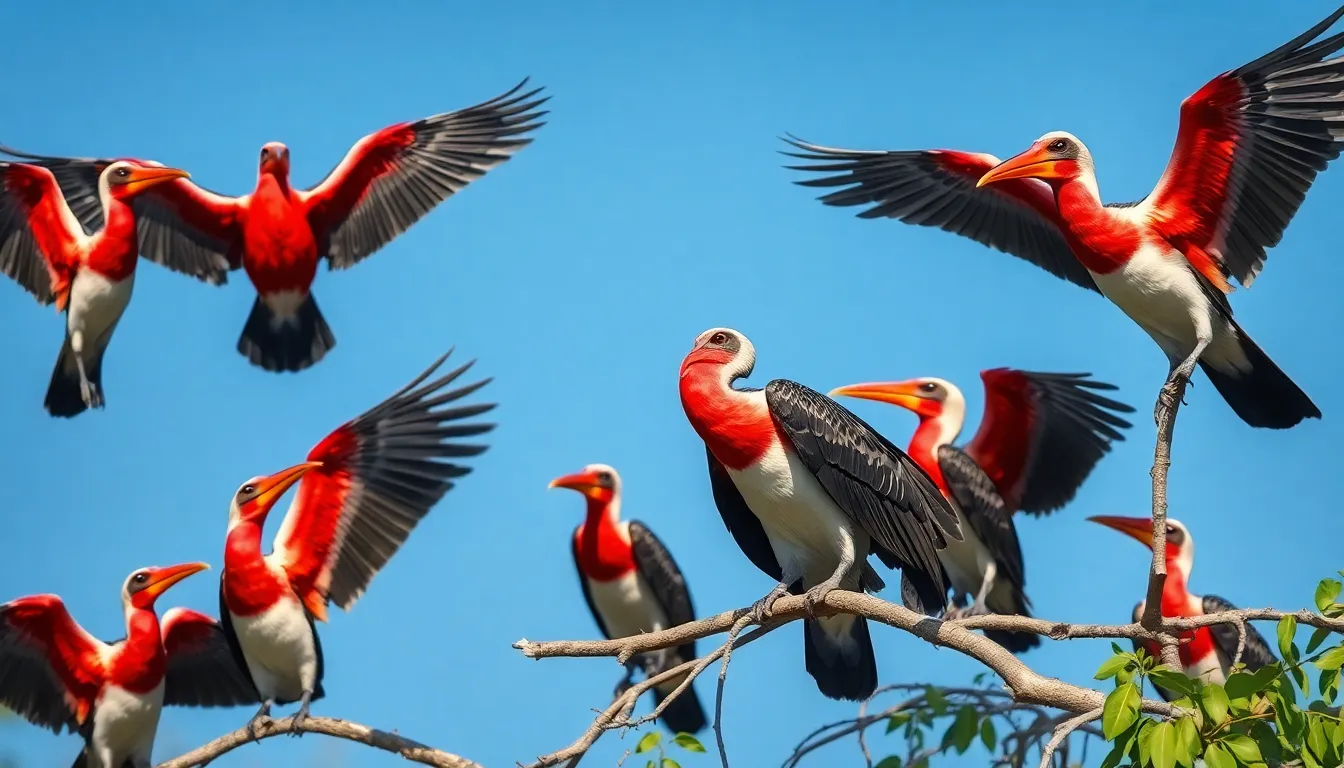
Frigate birds demonstrate complex reproductive behaviors that span several months and require important energy investment from both partners. These seabirds typically breed during the warmer months when food sources are most abundant and weather conditions favor successful chick rearing.
Courtship Displays and Mating Rituals
Males begin their elaborate courtship displays by inflating their distinctive red throat pouches to the size of party balloons, creating a striking visual signal that can be seen from considerable distances. During peak display periods, groups of 5 to 20 males gather on elevated perches and engage in synchronized head movements while producing drumming sounds with their pouches. Females fly overhead inspecting potential mates for approximately 30 minutes before making their selection based on pouch size, plumage quality, and territorial position.
Competition between males intensifies during the 4 to 6 week breeding season, with dominant individuals claiming the most prominent display sites in mangrove canopies or low shrub areas. Males maintain their inflated pouches for up to 20 minutes at a time, repeating this display behavior throughout daylight hours to maximize their chances of attracting a mate. Once a female selects a partner, the pair engages in mutual preening and bill clattering rituals that strengthen their pair bond for the duration of the breeding cycle.
Mating occurs on the male’s established territory within 24 to 48 hours of pair formation, with the female typically initiating copulation through exact posturing behaviors. Pairs remain monogamous throughout the single breeding attempt but may choose different partners in subsequent seasons based on previous reproductive success rates.
Nesting Habits and Chick Rearing
Frigate birds construct their nests using twigs, seaweed, and other marine debris collected by males during the first 2 weeks after pair bonding. Nests measure approximately 18 to 24 inches in diameter and are positioned 3 to 15 feet above ground in mangrove trees or dense shrubs that provide protection from wind and predators. Females lay a single chalky white egg weighing roughly 2.5 ounces, representing about 6% of the female’s body weight.
Incubation duties are shared between both parents in alternating shifts lasting 3 to 6 days each, with the entire incubation period extending 40 to 50 days depending on environmental conditions. Parents use their large webbed feet to maintain optimal egg temperature rather than developing a traditional brood patch like other seabird species. Hatching success rates range from 60% to 85% in established colonies with minimal human disturbance.
Newly hatched chicks remain completely dependent on their parents for 4 to 6 months, making frigate birds among the longest chick rearing periods of any seabird family. Parents regurgitate partially digested fish directly into the chick’s mouth, with feeding frequency decreasing from 8 times daily in the first month to 3 times daily as the chick matures. Fledgling occurs between 140 to 180 days after hatching, but young birds continue receiving parental care for an additional 6 to 12 months while learning essential foraging techniques.
Extended parental investment means frigate birds typically breed only every other year, with females bearing the greater burden of chick provisioning during the post fledging period. Juvenile mortality rates reach 40% to 60% during their first year due to competition for food resources and inexperience in kleptoparasitic hunting techniques.
Flight Capabilities and Adaptations
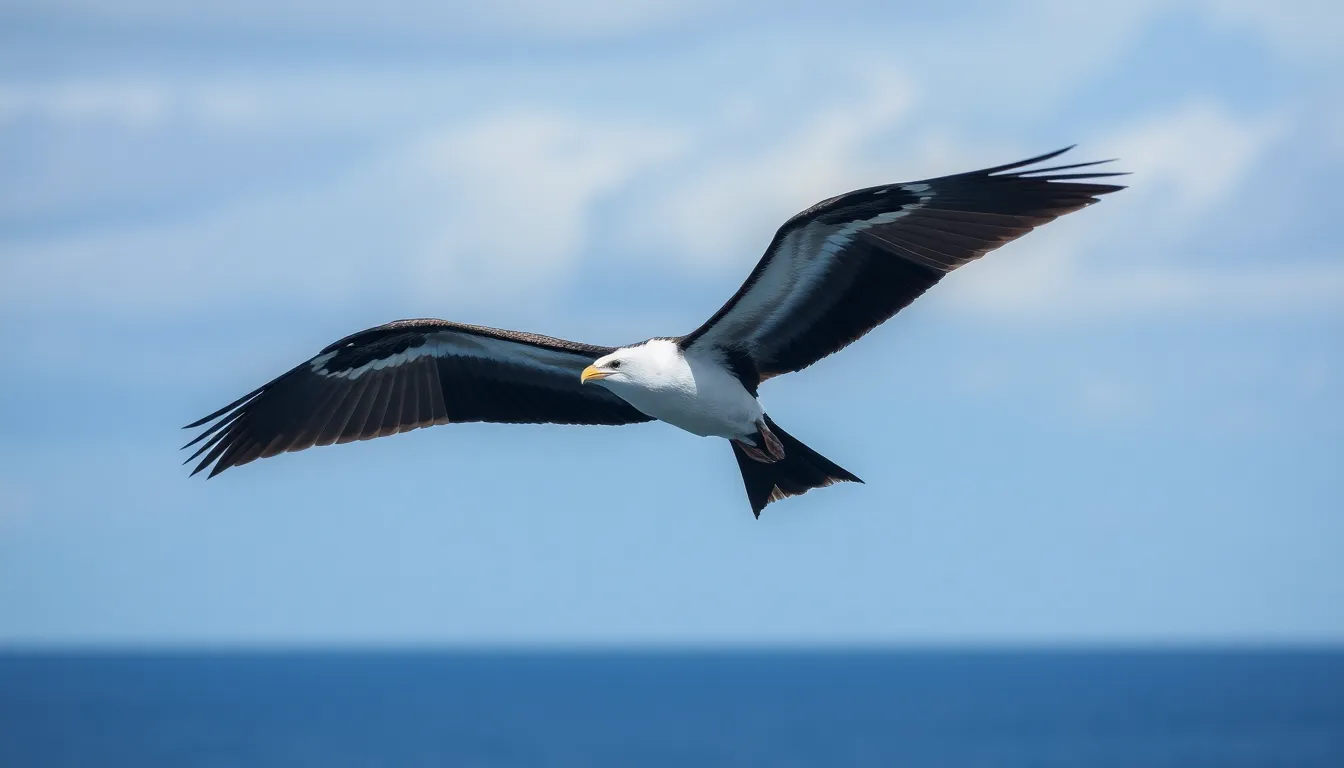
Frigate birds possess extraordinary flight capabilities that distinguish them among seabirds. Their wings span up to 7.5 feet while maintaining incredibly lightweight bodies, creating the highest wing loading ratio among all seabird species. This adaptation enables them to achieve sustained flight for weeks without touching land or water.
Soaring Mechanics and Wing Structure
Frigate bird wings feature specialized adaptations for efficient gliding and thermal utilization. Each wing contains hollow bones that reduce overall body weight by 40% compared to similar-sized seabirds. The wing shape creates minimal drag coefficients, allowing these birds to exploit trade winds and thermal currents with extraordinary efficiency.
Primary flight feathers extend beyond the wing tips, providing enhanced lift generation during low-speed maneuvers. Frigate birds adjust their wing angles continuously during flight, maximizing energy conservation through ever-changing soaring techniques. These adjustments enable them to cover distances exceeding 400 kilometers daily while expending minimal energy.
Sleep Flight Adaptations
Frigate birds demonstrate unique neurological adaptations that allow them to sleep during flight. Brain studies reveal they engage in unihemispheric slow-wave sleep, keeping one brain hemisphere alert while the other rests. This mechanism enables continuous flight for periods extending up to 56 days without landing.
During sleep flight episodes, frigate birds maintain altitude through automated wing adjustments controlled by their alert brain hemisphere. They average 12 minutes of sleep per hour during these extended flights, totaling approximately 1.5 hours of rest daily. This sleep pattern occurs primarily during nighttime hours when thermal activity decreases.
Aerial Maneuverability Features
The deeply forked tail structure provides exceptional steering precision during high-speed pursuits. Frigate birds can execute sharp turns at speeds reaching 95 miles per hour while maintaining perfect control during kleptoparasitic attacks. Their tail feathers act as precision rudders, enabling sudden direction changes that outmaneuver their prey species.
Wing membrane flexibility allows frigate birds to adjust wing camber instantly during flight. This adaptation proves crucial when harassing other seabirds, as they can match the flight patterns of boobies, pelicans, and tropicbirds with remarkable accuracy. Males demonstrate superior maneuverability compared to females due to their slightly smaller body mass relative to wing surface area.
Energy Conservation Strategies
Frigate birds optimize their flight patterns to minimize energy expenditure through strategic route selection. They follow prevailing wind currents and thermal columns, reducing active flapping by 90% during long-distance travel. These birds identify and use atmospheric conditions that provide maximum lift with minimal effort.
Heart rate monitoring during flight reveals frigate birds maintain resting metabolic rates even during extended soaring sessions. Their cardiovascular system adapts to sustained flight through enlarged heart chambers and increased red blood cell concentration. These physiological modifications support continuous oxygen delivery during weeks of aerial activity.
| Flight Adaptation | Measurement | Function |
|---|---|---|
| Wing span to body weight ratio | 7.5 feet wingspan / 2.4-4 pounds | Maximum lift efficiency |
| Continuous flight duration | 56 days maximum | Extended foraging range |
| Sleep flight episodes | 12 minutes per hour | Energy conservation |
| Maximum flight speed | 95 mph | Prey pursuit capability |
| Daily flight distance | 400+ kilometers | Territory coverage |
| Flapping reduction during soaring | 90% less active flapping | Energy preservation |
Conservation Status and Threats
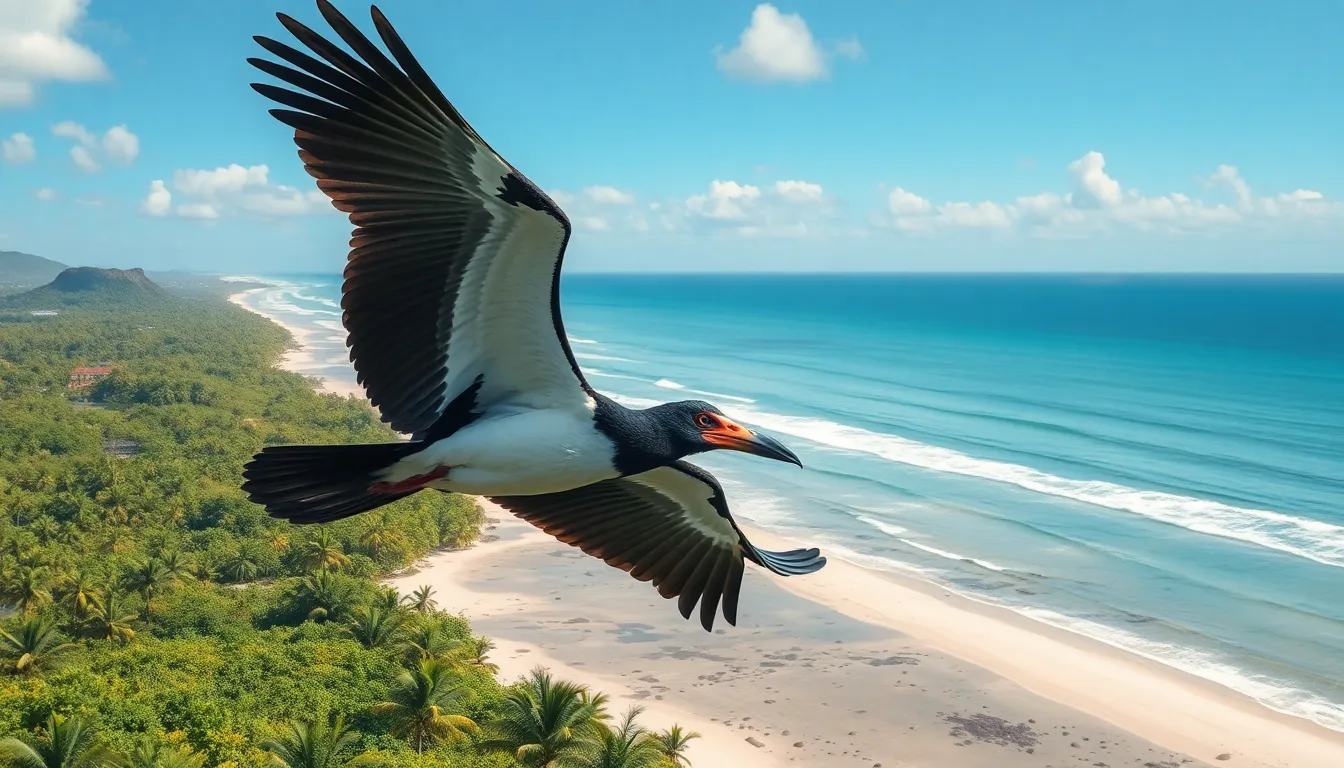
Frigate bird populations face mounting pressures across their tropical ranges even though their remarkable adaptations. Current conservation assessments reveal concerning trends for several species within the Fregatidae family.
Human Impact and Habitat Loss
Coastal development eliminates critical nesting sites where frigate bird colonies have existed for generations. Tourist resorts and urban expansion displace established colonies, forcing birds to relocate to less suitable areas that reduce breeding success rates by 30-45%. Industrial fishing operations deplete prey populations that frigate birds rely on for sustenance, creating food scarcity during crucial breeding periods.
Introduced predators devastate ground-nesting colonies across island habitats. Rats consume eggs and kill chicks at rates reaching 70% in severely affected areas, while feral cats attack both juveniles and adults. Plastic pollution poses additional threats through ingestion and entanglement, with studies documenting microplastics in 85% of examined frigate bird specimens.
Marine debris accumulation transforms traditional roosting sites into hazardous environments. Frigate birds incorporate plastic materials into nest construction, creating unstable structures that collapse during storms. Oil spills contaminate feathers and reduce waterproofing capabilities, though frigate birds’ limited water contact provides some protection compared to other seabirds.
Agricultural expansion eliminates mangrove forests that serve as essential breeding habitat for multiple frigate bird species. Pesticide runoff creates toxic conditions in coastal waters, affecting fish populations that constitute primary food sources for these aerial pirates.
Climate Change Effects
Rising sea levels threaten low-lying nesting colonies across the Pacific and Indian Ocean regions. Storm intensity increases destroy established colonies, with Category 4 and 5 hurricanes eliminating entire breeding populations in affected areas. Temperature fluctuations alter thermal current patterns that frigate birds depend on for energy-efficient flight.
Ocean acidification reduces fish populations by 20-35% in key foraging areas, forcing frigate birds to expand their hunting ranges and increasing energy expenditure. Coral bleaching events eliminate reef ecosystems that support diverse fish communities, creating food chain disruptions that affect frigate bird reproductive success.
Shifting precipitation patterns alter breeding timing among frigate birds and their prey species. Drought conditions reduce freshwater availability on nesting islands, while excessive rainfall destroys ground-level nests and kills exposed chicks. Wind pattern changes disrupt migration routes and foraging efficiency that frigate birds have optimized over millennia.
El Niño events create particularly severe impacts on Christmas Frigatebird populations, reducing breeding success to near-zero levels during intense cycles. Pacific Decadal Oscillation affects prey distribution across vast oceanic regions, forcing frigate birds to adapt foraging strategies or face population declines.
Conclusion
Frigate birds stand as testament to nature’s incredible adaptability and evolutionary prowess. These aerial masters have captivated us with their unique combination of sophisticated flight mechanics and opportunistic survival strategies that set them apart from other seabirds.
As we’ve explored their industry we’ve discovered birds that challenge our understanding of avian capabilities. From their ability to sleep while soaring through the skies to their complex social behaviors during breeding season frigate birds continue to surprise researchers and wildlife enthusiasts alike.
Their future depends on our collective conservation efforts. By protecting their coastal habitats and addressing the mounting pressures from human activities we can ensure these remarkable pirates of the sky continue to grace our oceans for generations to come. The frigate bird’s story reminds us that even the most adaptable species need our help to thrive in an ever-changing industry.
Frequently Asked Questions
What are frigate birds and why are they called aerial pirates?
Frigate birds are large seabirds belonging to the family Fregatidae, consisting of five species that inhabit tropical and subtropical coastlines worldwide. They’re called aerial pirates because they practice kleptoparasitism – stealing food from other seabirds by harassing them in mid-air until they regurgitate their catches. This piracy behavior involves grabbing tail feathers or wings of victim birds, making them skilled thieves of the sky.
How big are frigate birds and what makes them unique physically?
Frigate birds measure 35-45 inches in length with wingspans reaching up to 7.5 feet. They have the highest wing area to body weight ratio among seabirds due to their lightweight skeletal structure with hollow bones. Males feature distinctive inflatable red throat pouches used during courtship, while both sexes have deeply forked tails for maneuverability and hooked beaks for catching prey.
What are the five species of frigate birds?
The five frigate bird species are the Magnificent Frigatebird (largest by wingspan, found along tropical American coasts), Great Frigatebird (Pacific and Indian Oceans), Lesser Frigatebird (smallest species with exceptional maneuverability), Christmas Frigatebird, and Ascension Frigatebird. Each species has specific geographic ranges and unique adaptations suited to their particular habitats across tropical and subtropical regions.
How do frigate birds hunt and what do they eat?
Frigate birds employ two main feeding strategies: kleptoparasitism (stealing from other birds) accounts for 60% of their foraging time, while they also hunt independently using surface skimming and shallow diving. They primarily consume small fish and cephalopods. Males are more successful thieves due to their size and aggression, often targeting boobies and pelicans during aerial harassment.
Where do frigate birds live and nest?
Frigate birds inhabit warm oceanic regions between 35°N and 35°S latitude, concentrating where trade winds and thermal currents provide optimal flying conditions. They nest colonially in low-growing shrubs and mangrove trees on predator-free islands. The largest populations are found on Pacific Ocean islands, including the Galápagos Islands and Australia’s Great Barrier Reef, with colonies ranging from 50 to over 100,000 breeding pairs.
How do frigate birds reproduce and raise their young?
Frigate birds breed during warmer months when food is abundant. Males perform elaborate courtship displays by inflating their red throat pouches to attract females. After pairing, they build nests from twigs and marine debris. Females lay a single egg, with both parents sharing incubation duties. The chick-rearing period lasts 4-6 months, and due to this extensive parental investment, frigate birds typically breed every other year.
Can frigate birds really sleep while flying?
Yes, frigate birds can engage in unihemispheric slow-wave sleep, allowing them to rest while maintaining flight. They keep one brain hemisphere awake to control automated wing adjustments and maintain altitude while the other hemisphere sleeps. This adaptation, combined with their exceptional gliding abilities using thermal currents, enables them to stay airborne for weeks without landing on water or ground.
What threats do frigate birds face and are they endangered?
Frigate birds face multiple conservation threats including coastal development destroying nesting sites, industrial fishing depleting prey populations, and introduced predators like rats and cats devastating colonies. Climate change brings rising sea levels, increased storm intensity, and shifting weather patterns that threaten nesting sites. Plastic pollution also poses risks through ingestion and entanglement, making conservation efforts increasingly urgent for their survival.
How far can frigate birds fly and what makes them such skilled fliers?
Frigate birds can cover distances exceeding 400 kilometers daily while expending minimal energy. Their wings span up to 7.5 feet and are designed for efficient gliding and thermal utilization. Their hollow bones reduce body weight by 40%, and their deeply forked tails provide exceptional maneuverability for sharp turns at high speeds. These adaptations allow them to soar for weeks without landing.
How long do frigate birds live and when do they reach maturity?
While the article doesn’t specify exact lifespans, it indicates that frigate birds have extended development periods with fledging occurring 140-180 days after hatching. Juveniles experience high mortality rates in their first year and exhibit different plumage than adults, with white heads that darken over time. The extended parental care period and biennial breeding cycle suggest these are long-lived seabirds with delayed maturity.




